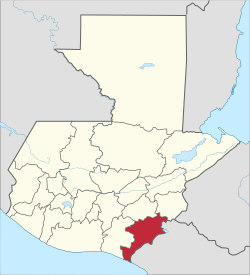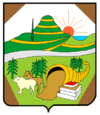Jutiapa Department
| Jutiapa | |||
|---|---|---|---|
| Department | |||
| |||
 Jutiapa | |||
| Country |
| ||
| Department | Jutiapa | ||
| Capital | Jutiapa | ||
| Municipalities | 17 | ||
| Government | |||
| • Type | Departmental | ||
| Population (Census 2002)[1][2] | |||
| • Religions | Roman Catholicism, Evangelicalism, Maya | ||
| Time zone | -6 | ||
Jutiapa is a department of Guatemala that borders along El Salvador and the Pacific Ocean. The capital is the city of Jutiapa. It has a population of about 489,085. The population is ethnically "mestizo" (European and non-indigenous) Though in the northern regions of Jutiapa there are few descendents that once belonged to the now extinct xinca population. The indigenous population is non existent today in Jutiapa with traditional language and culture no longer conserved or practiced. The department is divided into seventeen municipalities. Jutiapa is the country's southeastern-most department. The main crops are sorghum, tobacco, onion and corn. The climate is dry. An important attraction is the cattle fair. It is at 405 m above sea level.
The coat of arms contains the cornucopia symbolizing Jutiapa as the barn of the East, supplying Guatemala with most of the grain consumed by the people. The horse and the cow represent the cattle; the books stand for educational and cultural advances. In the background sits La Cruz hill, the firm guardian of the departmental chief town, with the tower or antenna of a Jutiapa radio station. Behind the hill float the clouds, the sky and the sun of Jutiapa, "The Sun City". This coat of arms is placed on the flag between two laurel branches symbolizing the daily triumphs of the sons of Jutiapa. The flag is mainly white, showing in its center the coat of arms adapted and adroned, between two laurel branches.
Municipalities
- Agua Blanca
- Asunción Mita
- Atescatempa
- Comapa
- Conguaco
- El Adelanto
- El Progreso
- Jalpatagua
- Jerez
- Jutiapa
- Moyuta
- Pasaco
- Quesada
- San José Acatempa
- Santa Catarina Mita
- Yupiltepeque
- Zapotitlán
References
- ↑ "XI Censo Nacional de Poblacion y VI de Habitación (Censo 2002)". INE. 2002.
- ↑ "Comunidad Lingüística Ch'orti'". Academia de Lenguas Mayas. 2008. Retrieved 2008. Check date values in:
|access-date=(help)
External links
Coordinates: 14°16′58″N 89°53′33″W / 14.28278°N 89.89250°W

